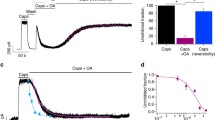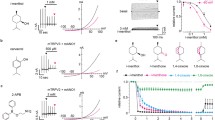Abstract
Inhalation of umbellulone (UMB), the offensive principle of the so-called “headache tree” (California bay laurel, Umbellularia californica Nutt.), causes a painful cold sensation. We therefore studied the action of UMB and some derivatives devoid of thiol-trapping properties on the “cold” transient receptor potential cation channels TRPA1 and TRPM8. UMB activated TRPA1 in a dose-dependent manner that was attenuated by cysteine-to-serine isosteric mutation in TRPA1 (C622S), while channel block was observed at higher concentration. However, although activation by mustard oil was completely prevented in these mutants, UMB still retained activating properties, indicating that it acts on TRPA1 only as a partial electrophilic agonist. UMB also activated TRPM8, but to a lower extent than TRPA1. Removing Michael acceptor properties of UMB (reduction or nucleophilic trapping) was detrimental for the activation of TRPA1, but increased the blocking potency. This was, however, attenuated by acetylation of the hydroxylated analogs. All UMB derivatives, except the acetylated derivatives, were also TRPM8 activators. They acted, however, in a bimodal manner, inhibiting the channel more potently than UMB, and with tetrahydro-UMB being the most potent TRPM8 activator. In conclusion, UMB is a bimodal activator of TRPA1 and a weak activator of TRPM8. Non-electrophilic derivatives of UMB are better TRPM8 activators than the natural product and also potent blockers of this channel as well as of TRPA1. The lack of effects of the acetylated UMB derivatives suggests that steric hindrance may prevent access to the recognition site for the bicyclic monoterpene pharmacophore on TRPA1 and TRPM8.








Similar content being viewed by others
References
Akhondina J, Kjanifar H, Raoofziaee M, Moayedpour A, Toosi MB, Khajedaluee M (2001) The effect of thymoquinone on intractable pediatric seizures (pilot study). Epilepsy Res 93:39–43
Appendino G, Minassi A, Pagani A, Ech-Chahad A (2008) The role of natural products in the ligand deorphanization of TRP channels. Curr Pharm Des 14:2–17
Avonto C, Taglialatela-Scafati O, Pollastro F, Minassi A, Di Marzo V, De Petrocellis L, Appendino G (2011) An NMR spectroscopic method to identify and classify thiol-trapping agents: revival of Michael acceptors for drug discovery? Angew Chem Int Ed Engl 50:467–471
Benemei S, Appendino G, Geppetti P (2009) Pleasant natural scent with unpleasant effects: cluster headache-like attacks triggered by Umbellularia californica. Cephalalgia 30:744–746
Benemei S, Nicoletti P, Capone JG, De Cesaris F, Geppetti P (2009) Migraine. Handb Exp Pharmacol 194: 75–89
Benemei S, Nicoletti P, Capone JG, Geppetti P (2009) CGRP receptors in the control of pain and inflammation. Curr Opin Pharmacol 9:9–14
Boedding MB, Wissenbach U, Flockerzi V (2001) Characterisation of TRPM8 as a pharmacophore receptor. Cell Calcium 42:618–628
Borhani Haghighi A, Motazedian S, Rezaiim R, Mohammadim F, Salarian L, Pourmokhtarim M, Khodaei S, Vossoughi M, Miri R (2010) Cutaneous application of menthol 10% solution as an abortive treatment of migraine without aura: a randomised, double-blind, placebo-controlled crossed-over study. Int J Clin Pract 64:451–458
De Maria S, Nqai J (2010) The cell biology of smell. J Cell Biol 191:443–452
Eastman RH (1954) Conjugative effects of cyclopropane rings. I. Synthesis and properties of 1-methyl-4-isopropyltricyclo[4,1,01,6,02,4]heptanon-5. J Am Chem Soc 76:4115–4117
Gertsch J, Leonti M, Raduner S, Racz I, Chen JZ, Xie XQ, Altmann KH, Karsak M, Zimmer A (2008) Beta-caryophyllene is a dietary cannabinoid. Proc Natl Acad Sci U S A 195:9099–10104
Guo J, Duan J, Shang E, Tang Y, Qian D (2009) Determination of ligustilide in rat brain after nasal administration of essential oil from Rhizoma chuanxiong. Fitoterapia 80:168–172
Guo J, Shang E, Duang J, Tang Y, Qian D (2011) Determination of ligustilide in the brain of freely moving rats using microdialysis coupled with ultra performance liquid chromatography/mass spectrometry. Fitoterapia 82:441–445
Heamy JP (1875) Oreodaphne californica. Am J Pharm 47:105–110
Herz RS (2001) Aromatherapy facts and fictions: a scientific analysis of olfactory effects on mood, physiology and behavior. Int J Neurosci 119:263–290
Hoeld KM, Sirisoma NS, Ikeda T, Narahashi T, Casida JE (2001) Alfa-thujone (the active component of absinthe): gamma-aminobutyric acida type A receptor modulation and metabolic detoxification. Proc Natl Acad Sci U S A 97:3826–3831
Karashima Y, Damann N, Prenen J, Talavera K, Segal A, Voets T, Nilius B (2007) Bimodal action of menthol on the transient receptor potential channel TRPA1. J Neurosci 27:9874–9884
Karashima Y, Prenen J, Talavera K, Janssens A, Voets T, Nilius B (2010) Agonist-induced changes in Ca(2+) permeation through the nociceptor cation channel TRPA1. Biophys J 98:773–783
Karashima Y, Talavera K, Everaerts W, Janssens A, Kwan KY, Vennekens R, Nilius B, Voets T (2009) TRPA1 acts as a cold sensor in vitro and in vivo. Proc Natl Acad Sci U S A 106:1273–1278
Macpherson LJ, Dubin AE, Evans MJ, Marr F, Schultz PG, Cravatt BF, Patapoutian A (2007) Noxious compounds activate TRPA1 ion channels through covalent modification of cysteines. Nature 445:541–545
Maffei ME, Gertsch J, Appendino G (2011) Plant volatiles: production, function and pharmacology. Nat Prod Res 28:1359–1380
Nassini R, Materazzi S, Vriens J, Prenen J, Benemei S, De Siena G, la Marca G, Andrè E, Preti D, Avonto C, Sadofsky L, Di Marzo V, De Petrocellis L, Dussor G, Porreca F, Taglialatela-Scafati O, Appendino G, Nilius B, Geppetti P (2011) The ‘headache tree’, via UMBELLULONE and TRPA1, activates the trigeminovascular system. Brain. doi:10.1093/brain/awr272
Nilius B, Mahieu F, Prenen J, Janssens A, Owsianik G, Vennekens R, Voets T (2006) The Ca2+-activated cation channel TRPM4 is regulated by phosphatidylinositol 4,5-biphosphate. EMBO J 25:467–478, England
Nilius B, Owsianik G, Voets T, Peters JA (2007) Transient receptor potential channels in disease. Physiol Rev 87:165–217
Nilius B, Prenen J, Owsianik G (2011) Irritating channels: the case of TRPA1. J Physiol 589:1543–1549
Peattie DC (1953) A natural history of western trees. Houghton Mifflin, Boston
Sherkheli MA, Vogt-Eisele AK, Bura D, Beltràn Màarques LR, Gisselmann G, Hatt H (2010) Characterization of selective TRPM8 ligands and their structure activity response (S.A.R.) relationships. J Pharm Pharm Sci 13:242–253
Starkenmann C, Cayeuz J, Brauchli R, Mayenzet F (2011) Hemisynthesis of dihidroumbellulols from umbellulone: new cooling compounds. J Agric Food Chem 59:677–683
Talavera K, Gees M, Karashima Y, Meseguer VM, Vanoirbeek JA, Damann N, Everaerts W, Benoit M, Janssens A, Vennekens R, Viana F, Nemery B, Nilius B, Voets T (2009) Nicotine activates the chemosensory cation channel TRPA1. Nat Neurosci 12:1293–1299
Acknowledgments
The work was supported by grants from the Belgian Federal Government (IUAP P6/28. BN), the Research Foundation-Flanders (F.W.O.) (G.0565.07 and G.0686.09, BN), and the Research Council of the KU Leuven (GOA 2009/07 and EF/95/010, BN). JZ was supported by grants from the Natural Science Foundation of China (no. 30900619) and the National Basic Research Program of China (no. 2012CB517806).
Author information
Authors and Affiliations
Corresponding author
Additional information
Jian Zhong and Alberto Minassi contributed equally to this work. Giovanni Appendino and Bernd Nilius share senior last authorship.
Electronic supplementary material
Below is the link to the electronic supplementary material.
Figure supplement
Modulation of TRPM8 activation by malonildihydroumbellulone. (a) Representative time course of whole-cell currents through TRPM8 measured at membrane potential of −80 mV (black circles) and +80 mV (red circles) induced by malonildihydroumbellulone and menthol at indicated concentrations. Note accentuated off-response after washout of 300 μM malonildihydroumbellulone, and its 100% block of the 100 μM MO response. (b and c) I–V relations measured at the times indicated in (a) (PDF 34 kb)
Rights and permissions
About this article
Cite this article
Zhong, J., Minassi, A., Prenen, J. et al. Umbellulone modulates TRP channels. Pflugers Arch - Eur J Physiol 462, 861–870 (2011). https://doi.org/10.1007/s00424-011-1043-1
Received:
Accepted:
Published:
Issue Date:
DOI: https://doi.org/10.1007/s00424-011-1043-1




